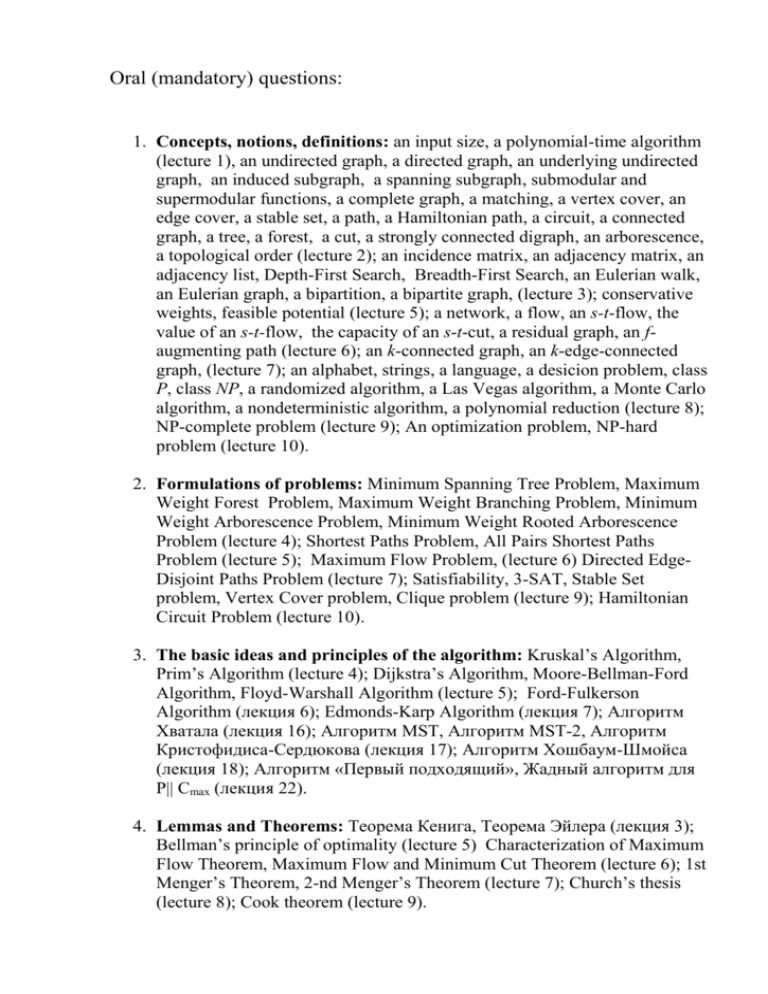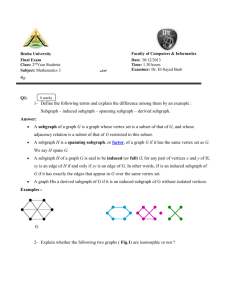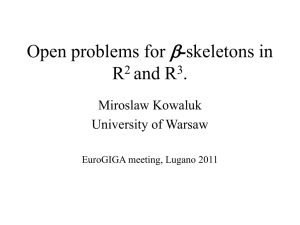graph arbitrary
advertisement

Oral (mandatory) questions:
1. Concepts, notions, definitions: an input size, a polynomial-time algorithm
(lecture 1), an undirected graph, a directed graph, an underlying undirected
graph, an induced subgraph, a spanning subgraph, submodular and
supermodular functions, a complete graph, a matching, a vertex cover, an
edge cover, a stable set, a path, a Hamiltonian path, a circuit, a connected
graph, a tree, a forest, a cut, a strongly connected digraph, an arborescence,
a topological order (lecture 2); an incidence matrix, an adjacency matrix, an
adjacency list, Depth-First Search, Breadth-First Search, an Eulerian walk,
an Eulerian graph, a bipartition, a bipartite graph, (lecture 3); conservative
weights, feasible potential (lecture 5); a network, a flow, an s-t-flow, the
value of an s-t-flow, the capacity of an s-t-cut, a residual graph, an faugmenting path (lecture 6); an k-connected graph, an k-edge-connected
graph, (lecture 7); an alphabet, strings, a language, a desicion problem, class
P, class NP, a randomized algorithm, a Las Vegas algorithm, a Monte Carlo
algorithm, a nondeterministic algorithm, a polynomial reduction (lecture 8);
NP-complete problem (lecture 9); An optimization problem, NP-hard
problem (lecture 10).
2. Formulations of problems: Minimum Spanning Tree Problem, Maximum
Weight Forest Problem, Maximum Weight Branching Problem, Minimum
Weight Arborescence Problem, Minimum Weight Rooted Arborescence
Problem (lecture 4); Shortest Paths Problem, All Pairs Shortest Paths
Problem (lecture 5); Maximum Flow Problem, (lecture 6) Directed EdgeDisjoint Paths Problem (lecture 7); Satisfiability, 3-SAT, Stable Set
problem, Vertex Cover problem, Clique problem (lecture 9); Hamiltonian
Circuit Problem (lecture 10).
3. The basic ideas and principles of the algorithm: Kruskal’s Algorithm,
Prim’s Algorithm (lecture 4); Dijkstra’s Algorithm, Moore-Bellman-Ford
Algorithm, Floyd-Warshall Algorithm (lecture 5); Ford-Fulkerson
Algorithm (лекция 6); Edmonds-Karp Algorithm (лекция 7); Алгоритм
Хватала (лекция 16); Алгоритм MST, Алгоритм MST-2, Алгоритм
Кристофидиса-Сердюкова (лекция 17); Алгоритм Хошбаум-Шмойса
(лекция 18); Алгоритм «Первый подходящий», Жадный алгоритм для
P|| Cmax (лекция 22).
4. Lemmas and Theorems: Теорема Кенига, Теорема Эйлера (лекция 3);
Bellman’s principle of optimality (lecture 5) Characterization of Maximum
Flow Theorem, Maximum Flow and Minimum Cut Theorem (lecture 6); 1st
Menger’s Theorem, 2-nd Menger’s Theorem (lecture 7); Church’s thesis
(lecture 8); Cook theorem (lecture 9).
5. To be able to prove that P NP
Exersices.
•
•
•
•
•
•
•
•
•
•
•
•
•
•
•
Let G be an undirected graph, and let (V(G), F1) and (V(G), F2) be two
forests in G with |F1| < |F2|.
Prove that there exists an edge e ∈ F2\F1 such that (V(G), F1⋃{e}) is a
forest.
Let G be a simple undirected graph. Show that G or its complement is
connected.
Show that any undirected graph has a cut containing at least half of the
edges.
Given a graph G, show that there is a linear-time algorithm to find a circuit
or decide that none exists.
Given a digraph G, show how to identify the strongly connected component
in polynomial time. What is running time of your algorithm?
Prove that a strongly connected digraph whose underlying graph is nonbipartite contains a directed circuit of odd length.
Given an undirected graph G with arbitrary weights c: E(G) → R. We ask
for a minimum weight connected spanning subgraph. Can you solve this
problem efficiently?
Given an undirected graph G with weights c: E(G) → R and a vertex v ∊
V(G). We ask for a minimum weight spanning tree in G where v is not a leaf.
Can you solve this problem in polynomial time?
Show that in the case of integer capacities, the Ford-Fulkerson Algorithm
may have an exponential number of augmentations.
Prove: If Π =(X, Y) ∈ NP, then there exists a polynomial p such that Π can
be solved by a deterministic algorithm having time complexity O(2p(n)),
where n is the input size.
Prove NP-completeness of Vertex cover and Clique.
Prove that the TSP is NP-hard.
Prove that the QAP0 is NP-hard.
The decision problem Clique is NP-complete. Is it still NP-complete if
restricted to a) bipartite graphs, b) planar graphs.










